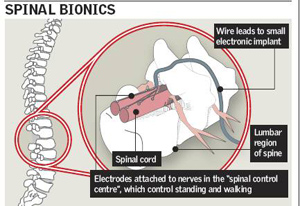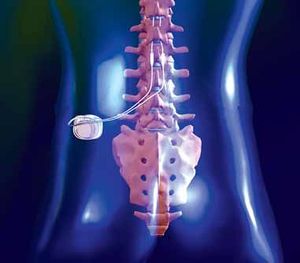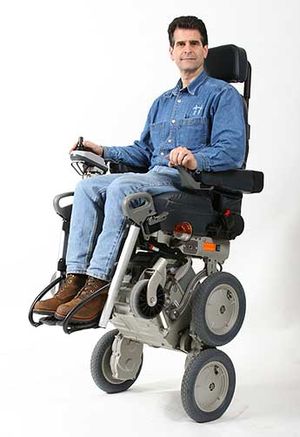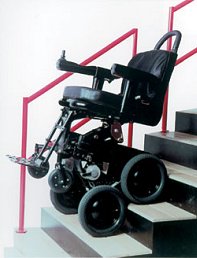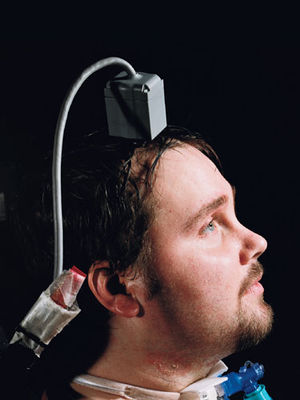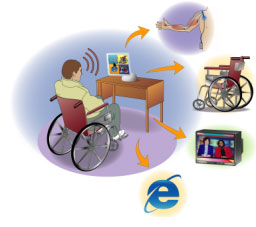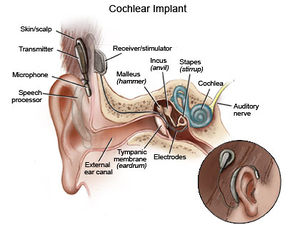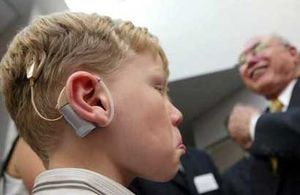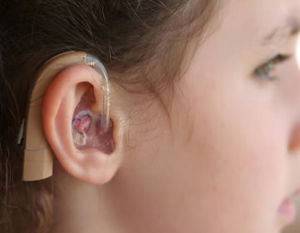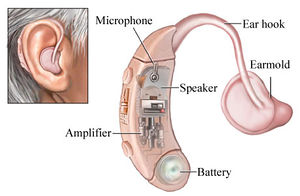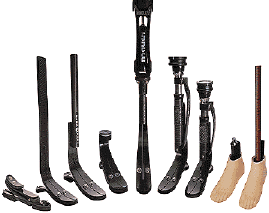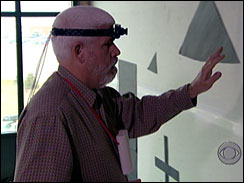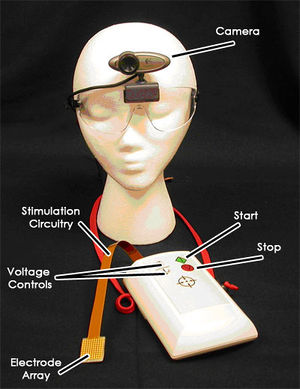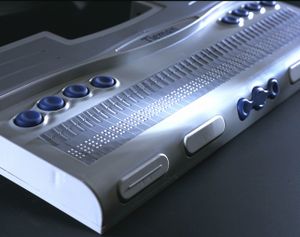Technology for the Disabled
Contents
Group Information
Team Name
Team Members
Camille Sokol - clsokol@ucalgary.ca
Jesse Dors - jrdors@ucalgary.ca
Jordan Kersch - jjkersch@ucalgary.ca
Allisha Stauffer - amstauff@ucalgary.ca
William Chung - whchung@ucalgary.ca
Introduction
As we all know, technology in the 21st century is getting better and more complex, on a seemingly exponential level of growth. Also, more and more people are forced to live with disabilities that are making their quality of life much worse than it could be. What our group chose to report was the new technology that is starting to change the quality of life for the disabled, in a positive direction. In the last ten years alone, technology for the disabled has gotten much, much better, and we felt that this would be a great issue to bring forth.
Paralysis Technology
In this day and age, we are seeing an increasing amount of human beings with paralysis disabilities. Quadriplegia, the complete paralysis of the body from the neck down, and Paraplegia, the paralysis of both legs (most commonly caused by spinal cord injury) are the most infamous cases of paralysis. Luckily, with all the advances in technology in the 21st century, people with paralysis are beginning to see the world in a whole new light. Improved technologies for pre-existing aides such as wheelchairs are considerably better than before, and even internal projects that require surgery are on the rise.
Paraplegic
Spinal Bionics: Canadian and Australian researchers have designed a device that is permanently implanted into the lower spine of paraplegic patients.Its function is to basically stimulate the nerves that the brain no longer can control within the Lumbar Enlargement region of the spinal column. Once the design of the implant is mastered, patients will be able to have up to as much control and muscle movement in their legs as able-bodied people. All this can still be controlled by the brain as if there were no spinal injury in the first place. There are still a few medical hurdles (i.e. the lack of microscopic tools small enough for doctors to perform the procedure) to overcome before this device is to function 100%, but it is only a couple years away.
Quadriplegic
The Quadriplegic Wheelchair: People who live with quadri- or tetraplegia (both mean the paralysis of all four limbs) have been confined to a wheelchair for mobility since the wheelchair was invented. The technology of our time has made wheelchairs much more mobile now, and most importantly, some are useable by the disabled. Otherwise, they would have to live with the burden of being pushed around by a loved one or friend all of the time. Specifically, the design of the head-controlled power wheelchair is a huge leap. The RCC Institute of Technology, for example, has designed a chair that is customizable to the amount of functionality the patient has with his/her body. So, if a patient has partial movement of say, their shoulders, they can use their shoulders to perform pre-determined functions. In general, the basic idea is a control device that is operated by the head. Turning your head left or right can move the wheelchair in that respective direction (http://www.youtube.com/watch?v=vOuSrZvCiGQ), and a small control device operated by the mouth can perform other tasks such as forward and backward motion.
BrainGate: In all the newer technology available to disabled, perhaps the most amazing and unbelievable is BrainGate. Created by Cyberkinetics Neurotechnology Systems, Inc., is a neural interface system, which functions from a microchip implanted inside the brain. It seems like a farfetched idea from a science fiction movie, but in reality is a fully achievable goal for our society. Currently the chip uses 96 hair-thin electrodes that sense the electro-magnetic signature of neurons firing in specific areas of the brain, for example, the area that controls limb movement. The system uses a sensor that lays on the motor cortex of the brain and analyzes and interprets brain signals. The chip, powered quite literally by the human brain, can control a remarkable amount of things. For example, not only can the chip move arms or legs of the patient, but electronic gadgets and things in the patient’s world. Things like communication via telephone or e-mail can happen without touching a single keypad or keyboard. Just by thinking about it, the BrainGate chip can allow its users to use computers, control the television, the user’s wheelchair, practically any electronic device, so long as it can be programmed. Although the FDA still classifies BrainGate as an ‘investigational’ device, it is available through a clinical study and is already active and functional inside a few daring patients. Once all the bugs are worked out, however, I believe this will be the single most spectacular piece of technology available for the paralyzed.
Deaf and Hard of Hearing
Cochlear Implants
Perhaps the most prominent technology for the deaf and hard of hearing, Cochlear implants create an almost true sense of hearing. Previously, CI’s were more controversial in the deaf community, but it is estimated that nearly 100000 deaf and hard of hearing worldwide have had cochlear implants. The future holds promise for the deaf as these implants are on the rise and are improving all the time.
What is a Cochlear Implant?
A cochlear implant (CI) is a device which gives the wearer a sense of sound.. A cochlear implant is composed of two pieces, an external and internal piece. Unlike a hearing aid, which amplifies sound, a CI bypasses the outer ear and transmits electrical signals directly to the inner ear. Often a CI is not enough and must be used in conjunction with signlanguage or speechreading.
A video exmplaining cochlear implants: http://video.about.com/deafness/Cochlear-Implants.htm
How Does a Cochlear Implant Work?
The implant is surgically placed under the skin in the skull behind the ear. Primarily, the sound is collected and transformed and sent beyond the damaged cells of the ear and directly stimulate the auditory nerve. The basic parts of the device and what they do include:
External:
- Microphone: which collects sound from the environment and gives the vibrations to the speech processor.
- Speech processor: which selectively filters sound to prioritise audible speech and transforms the vibrations into electrical signals. It then sends it to the transmitter.
- Transmitter: behind the external ear, and transmits the electric signals to the internal device by electromagnetic process called induction
Internal:
- A receiver and stimulator found in the skull converts the signals into electric impulses and sends them through an internal cable to electrodes (up to 22), which is threaded through the cochlea, which then stimulates the auditory nerve and sends the message to the brain.
Advantages and Disadvantages
Advantages
- Communication
- Easy maitenance
- Learning capabilities
Disadvantages
- Expensive
- Permanent
- Damage and infection
- Surgery
Hearing Aids
The most Common technology for the deaf and hard of hearing, an estimated 2% of Americans are now wearing hearing aids.
What is a Hearing Aid and What do they do?
A hearing Aid is an electronic Device worn around or in the ear in order to amplify the sound. With increased Volume, the wearer can hear noise that previously would have gone unheard. There are Four different general styles of hearing aid; behind the ear, In the ear, In the canal, and completely in the canal. Although there are four different types, all hearing aids contain four common components:
- A microphone. Picks up Sound waves and converts it to electrical impulses
- An amplifier. Increases the strength of impulse. (increase volume of the sound.)
- A receiver. Transforms the electrical impulses back into sound waves and sends them into the inner ear of the wearer..
- A battery. The battery provides power to the electronic parts.
How do they Work?
Hearing Aids work differently depending on the electronics used for them. There are two main types, Analog and Digital. Analog hearing aids convert the incoming sound waves into electrical signals. Analog hearing aids generally have more than one setting for various sound environments, both loud and quiet. Digital aids convert the sound waves into a numerical code which is later decoded into sound again. The important part about digital aids is that attached to certain codes are frequencies and depending on what you want, certain sounds can be amplified more than others.
Other Assistive Listening Devices and Systems
An Assistive listening device is one of many devices which assists deaf or hard of hearing in situations where a hearing aid or cochlear implant is inadequate. They are designed to enhance communication in situations with a lot of background noise or group situations.
Induction Loops
A magnetic field is created by passing current through wire, the basis of magnetic induction. This technology is applied to the wire and is worn around the wearers neck, allowing them to listen to tv, music, and telephones without headphones. The signal is transferred to the telecoils in the hearing aid by induction. This system is cheap and portable but not all hearing aids have telecoils.
FM Systems
FM systems work much like a regular radio. A transmitter sends out signals through FM radio to receivers which are worn on the person. Although these systems are not the most private or confidential, they are highly portable and convenient. These can be used with induction loops, certain hearing aids, and cochlear implants. There are even systems such as Audisee that include a real-time visual transmission along with radio transmission, making it easier to hear while simultaneously speechreading. This makes it ideal for the classroom setting.
Infared
The infared system is fairly similar to the FM systems. It works much like a television remote. In this system, infared signals are sent out via an LED laden projector. These are then collected by the receivers and the light signals are transformed into sounds. This system is more private as light cannot travel through walls and is often used in court cases.
Captioning
Closed captioning is one of the simplist forms of technology for deaf and hard of hearing. What captioning does is it encodes text to a program and the television decodes it as it plays. What this does is it applies a dialogue to the audio part of a video or television program making it possible for the deaf and hard of hearing to read what is happening, instead of hearing.
Amputees & Prosthetics
A Brief History of Prosthetics
Prosthetics go as far back as the Fifth Egyptian Dynasty (2750BC - 2625BC) and from this period, archaeologists have discovered the oldest known splint. The earliest written reference to an artificial limb dates back to 500BC when a prisoner broke loose from his chains by cutting his foot off, and then later replacing his foot with a wooden substitute. In 1529, surgeons were using amputations as life saving procedures. It was shortly after, that the development of prosthetics was underway.
How Amputees Use Prosthetics and the Complications
Prosthetics limbs were designed to provide a simulation of the limb that was lost, by replacing it with a mechanical one. They give motility back to the amputee patients that have lost limbs, and assist with the every day activities that people take part in each day, whether it be walking or writing, or participating in recreational activities. Prosthetics have made it easier for amputee patients to deal with the loss of a limb which can be difficult to overcome. Some patients experience what is called Phantom Limb Pain (PLP) where they experience discomfort in a limb that is missing.
Advances in Technology for Prosthetics
One of the technologies that is being considered for improving prosthetics, is the thought controlled computer. There are experiences taking place in Germany to determine if these computers can be controlled by thought alone. For amputees, this means that any electronically controlled limbs have the potential to one day be controlled by thought. This would give amputee patients better control over their prosthetic limbs, and make the prosthetic limb seem more like a real limb since they can now control it with their thoughts. There are also experiments with technologies underway at Northwestern University in Chicago. These experiments have shown that we can transplant the nerves from a patients amputated hand to their chest, and this allows the patient to feel hand sensations there. The transplanted nerves grow into the muscle, and this amplifies the messages once they are sent to the arm and hand and these signals are then read by sensors that are located on the prosthetic limb. These sensors then translate the readings into movement.
The Issue with the Technology of Prosthetics
Since the advances that are taking place in technologies that are improving the use of prosthetics are brand new and exciting amputee patients, obtaining the use of the technologies will most likely be very expensive. Unfortunately average people will not be able to afford these new technologies once they become available. As in most cases when a new technology is introduced into the public, several patients will have to wait until the cost comes down, and the products become affordable to them. By this time, there may be a new and improved technology in the works.
Technology for the Blind
BrainPort
The BrainPort is a Device that actually allows Blind people to see. This happens through a series of wire that attach to the persons tongue. A camera captures light that would normally hit the retina. Each pixel captures has a corresponding electrode sent to a wire attached to the tongue. At first the brain doesn't pick up these signals as visual images, but eventually it see's the impulses as coming from tongue as it was coming from the eyes. It does this by sending the electrical impulses to the touch receptor in the brain and the stem of the brain. The brain learns to interpret this data and creates a blurry image. It is a mystery still how the brain learns to interpret this data correctly.
If "seeing" means there's activity in the vision center of the cerebral cortex, then the blind subjects are really seeing. This is a huge innovation in not only sight impairment research but in science altogether. Many fields of studies can be branched off this technology(others are already being researched such as deafness and balance problems) and one day someone completely blind will be able to see like a normal individual, maybe even better, with the use of this technology.
Interesting Fact: The U.S. military has invested alot of money into this tehnology in the hopes of developing it to a level where their soldiers may have super-human senses, similar to those of animals such as owls, snakes, and fish. The military has said it has the potential to transfer images from cameras, comapsses, and sonar. This shows the power of this technology and its hope to allow visually impaired individuals to live a normal life.
Here is a link to a breif video explaining how brainport works and a case study of one user.
It actually shows how he can go through obstacle courses and navigate through an office building. Also a user who has never used it puts it on and goes for the ride...sit back and enjoy this exciting innovative technology.
www.youtube.com/watch?v=OKd56D2mvN0
How Visually Impaired Indiviuals Use Computers
There are two types of adaptive software for visually impaired people to use computers, depending on the level of their blindness.
Screen-Reader
The most widely used screen reader is JAWS(job access with speech) that is used by both high school and college students. All output must be auditory and the individual must learn many hotstrokes because they cannot see where the mouse is pointed. These programs are advanced enough to use multiple voices and sounds to interpret information. They can read up to 300 words per minute, twice the speed of a human conversation). Screen-Readers are very difficult to learn how to use, and take much practice because of the hotstrokes one must learn to control the computer. The individual must also learn how to use the Braille keyboard. The typical price range for screen-readers is anywhere from $500-$1600 Canadian dollars. While a screen reader and magnification combo range from $500-$2500. If the individual is both blind and deaf they must rely completely on Braille display. Braille display is something one sets over their keyboard and as the screen reader is reading it sends the information to the keyboard and pushed metal pins up displaying the content in Braille for the person to interpret.
Magnification Programs
Individuals who can see a little usually opt to use a magnification program. These programs can magnify up to 36x. They also offer variations in colors and some speech programs. These type of programs are a lot easier to use then screen-reader`s so many choose this type of program. With a series of clicks text is quickly maginified and contrasted to certain colors which are easy for the user to read and interpret. The price range for such programs is anywhere from $200-$1000 Canadian dollars.
Some other featues of magnification programs are:
-Dual Montior Support: One can hook up 2 monitors to expand the view wanting to be seen.
-Focus Enhancements: This is a feature which allows the user to navigate through the computer while a bright box is highlighted and easy to see where the point of focus(wear the "mouse" is on screen) is incase one loses track.
-Cursor Enhancement: This is a feature that allows the user to change colors, shading, and sizes.
These are just a few of the features offered by such programs.
Here are a few Functional, downloadable Demo`s of the products. You may want to test Jaws out and see just how hard it is to use a program like this without sight and get a better understanding of the trouble a visually impaired individual must go through to use a common technology like a computer.
Jaws: http://www.freedomscientific.com/downloads/jaws/jaws9-downloads.asp
Windows-Eyes: http://www.gwmicro.com/
MAGic: http://www.freedomscientific.com/downloads/magic/magic11-downloads.asp
ZoomText: http://aisquared.com/index.cfm
Chronic Pain
- a pain when it lasts for such a long time.
- tough to treat because it varies from person to person. For instance, two people with the same kind of pain need to be treated differently.
- It can be changed frequently by day to day or week to week and it can be hourly even.
How the pain can be reached?
Pain is the body's normal response to harm or possible damage. Pain causes when special nerve endings, often referred as pain receptors, are turned on because of illness or injury or when chemical changes within the body indicate that body tissues are damaged. When a pain receptor is turned on, it gives the release of chemicals that sends a signal to the brain. The signal travels within the spinal cord to the brain, which recognizes the signal as pain.
ANS(Autonomic Nervous system)
It’s a device that gives electrical impulses sent to one’s spine through very thin leads and it blocks the pain signaling to the brain and it even replaces the pain with a massage or tingling sensation.
Resources
Paralysis Technology - Jesse Dors
http://www.abc.net.au/worldtoday/content/2008/s2421730.htm
http://www.thewest.com.au/default.aspx?MenuID=158&ContentID=108410
http://ieeexplore.ieee.org/stamp/stamp.jsp?arnumber=00656979
http://www.ibotnow.com/functions/mobility-system.html
http://www.pubmedcentral.nih.gov/articlerender.fcgi?artid=1878697
http://www.youtube.com/watch?v=vOuSrZvCiGQ
http://www.cyberkineticsinc.com/content/medicalproducts/braingate.jsp
http://en.wikipedia.org/wiki/BrainGate
http://www.wowt.com/news/features/2/1658247.html
Deaf & Hard of Hearing - Camille Sokol
http://en.wikipedia.org/wiki/Cochlear_implants
http://www.nad.org/site/pp.asp?c=foINKQMBF&b=399061
http://www.helium.com/items/529772-the-pros-and-cons-of-cochlear-implants
VIDEO http://video.about.com/deafness/Cochlear-Implants.htm
http://deafness.about.com/cs/cochlearimplants/a/cifacts.htm
IMAGE http://medgadget.com/archives/2005/04/nanoscience_mee.html
http://www.michdhh.org/assistive_devices/hearing_assistive_tech.html#alds
http://deafness.about.com/cs/accessibility/a/webvideocc.htm
IMAGE http://www.soundhearingaid.com/
IMAGE http://www.2ears2hear.org.uk/cochlearimplants.htm
http://www.audisoft.net/en/Products/Audisee.html
http://www.hearingloss.org/learn/assistivetech.asp
http://deafness.about.com/cs/accessibility/a/captioning.htm
http://www.captioncentral.com/
IMAGE http://64.143.176.9/library/healthguide/en-us/support/topic.asp?hwid=zm6101
http://www.hearingresearch.org/Dr.Ross/OTChearingaids.htm
http://www.nidcd.nih.gov/health/hearing/hearingaid.asp
http://www.hearingaids101.com/how-hearing-aids-work.aspx
Amputees & Prosthetics - Allisha Stauffer
http://blog.cognitivelabs.com/2006/03/mental-typewriter-and-game-controller.html
http://inventors.about.com/library/inventors/blprosthetic.htm
http://www.technologyreview.com/Biotech/19759/
http://www.armsandlegsfoundation.org/
http://genjerleigh.blogspot.com/2008/09/no-money-no-fun.html
http://wootenreunion2006.com/Saturday_15.html
http://www.sputnikdesignworks.com/clipart/people.html
http://www.fda.gov/Fdac/features/1997/297_step.html
http://www.sciencedaily.com/releases/2006/11/061115093227.htm
http://www.technologyreview.com/biomedicine/18134/
Technology for the Blind - Jordan Kersch
http://science.howstuffworks.com/brainport.htm
Image joeclark.org/nypl/20Tiemann-closeup.jpg
http://www.associatedcontent.com/article/805781/how_do_blind_people_use_computers.html?cat=15
http://joeclark.org/book/sashay/serialization/Chapter03.html
image wwwimage.cbsnews.com/images/2007/01/18/image2373558g.jpg
image static.howstuffworks.com/gif/brainport-vision-diagram.jpg
image www.freedomscientific.com/images/jaws-hq-banner.jpg
image www.pacificvision.info/images/freedom/magic.jpg
image www.maxiaids.com/ProdImages/802478.jpg
http://www.youtube.com/watch?v=OKd56D2mvN0
http://www.geekologie.com/2006/04/brain_port_tongue_interface.php
http://www.nctec.co.za/products/screen_magnification_software.html
Chronic Pain - William Chung
http://i53.photobucket.com/albums/g75/DMCU_1990/peripheral_nervous_system_chart.jpg&imgre
http://amysweetmanpsychwiki.com/pmwiki/pmwiki/pmwiki.php%3Fn%2Bsystem%26start%3D100%26ndsp%
http://en.wikipedia.org/wiki/Amyotrophic_lateral_sclerosis
http://en.wikipedia.org/wiki/Autonomic_nervous_system
http://www.eonmini.com/abouteon.htm
http://www.als.ca/lou_gehrigs_disease.aspx
http://www.tcmtreatment.com/images/diseases/ALS-Report.htm
http://www.ans-medical.com/patient/prepareforyourphysiciansvisit/video.cfm
http://faculty.washington.edu/chudler/auto.html
http://www.americanheart.org/presenter.jhtml?identifier=4463
